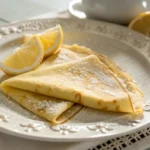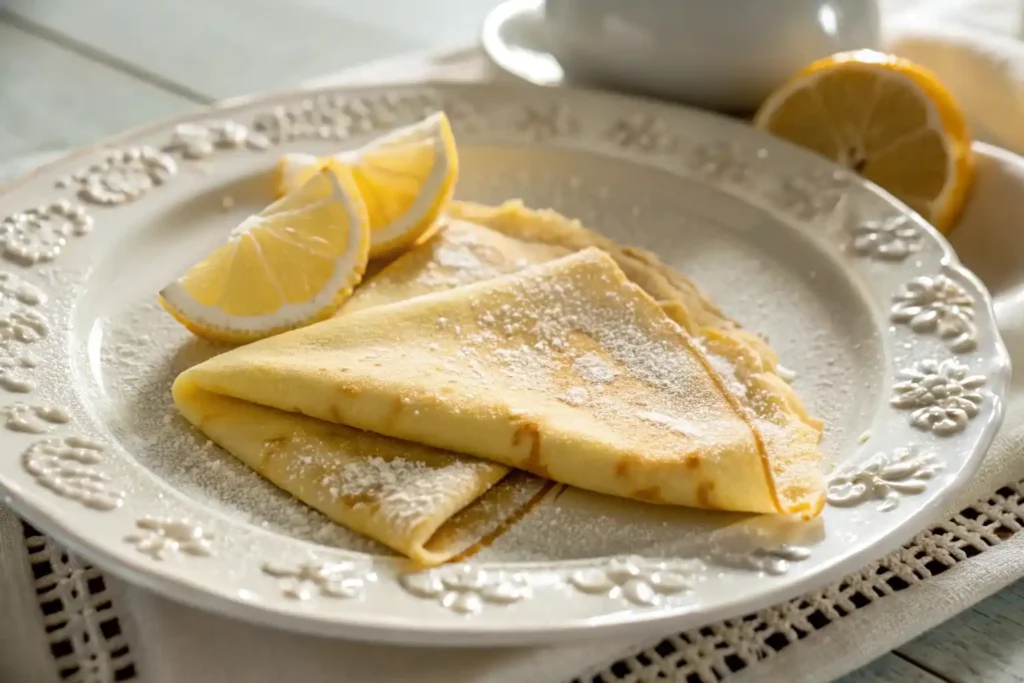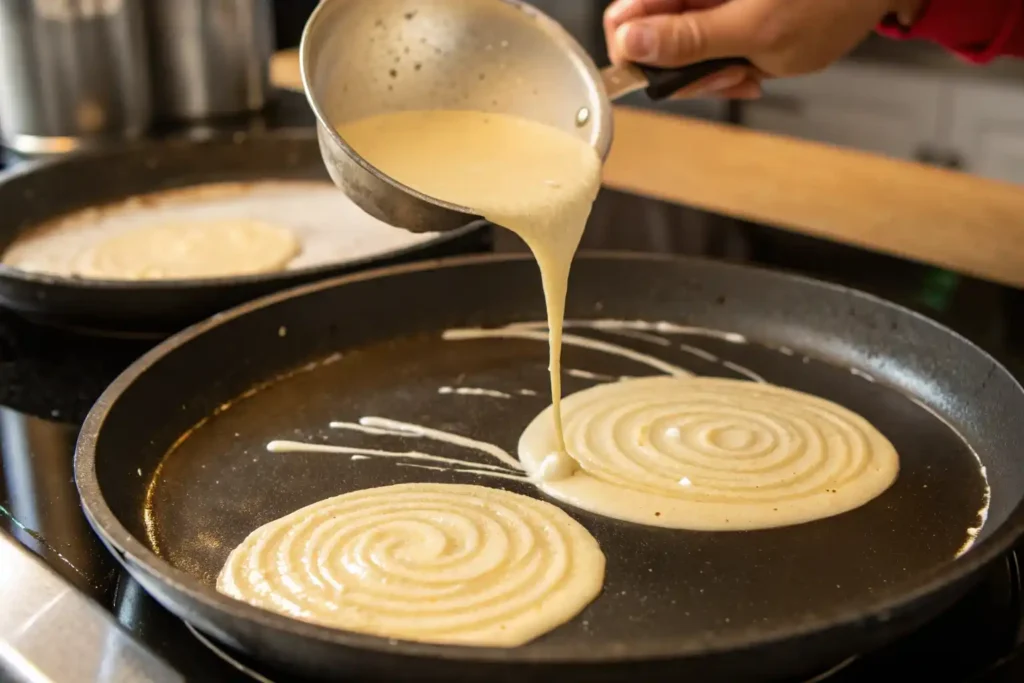Perfect pancakes have been the holy grail of my breakfast cooking journey, and today I’m sharing this foolproof perfect pancakes recipe that delivers consistently beautiful, thin, golden pancakes every single time. There’s something magical about mastering the art of pancake making – the satisfaction of creating those delicate, lace-like edges and achieving that perfect golden color that makes everyone gather around the kitchen.
This perfect pancakes recipe isn’t about thick, fluffy American-style pancakes – it’s about creating those elegant, thin pancakes that are crispy around the edges yet tender in the center. The technique might seem simple, but understanding the proper method makes all the difference between good pancakes and truly perfect pancakes that look and taste like they came from a professional kitchen.
Whether you’re planning a special weekend breakfast, celebrating a holiday tradition, or simply want to master one of cooking’s fundamental skills, this perfect pancakes recipe will give you the confidence and technique to create beautiful pancakes that work equally well with sweet or savory fillings.
Ingredients
For the Basic Batter:
- 100g plain flour
- 2 large eggs
- 300ml semi-skimmed milk
- 1 tablespoon sunflower oil or vegetable oil, plus extra for frying
- Pinch of salt
Optional Enhancements:
- 1 teaspoon vanilla extract (for sweet pancakes)
- 1 tablespoon sugar (for slightly sweet pancakes)
Instructions
1. Create the Flour Foundation Place 100g of plain flour and a pinch of salt into a large mixing bowl. The salt might seem unnecessary, but it actually enhances the overall flavor and helps strengthen the batter structure for perfect pancakes. Create a well in the center of the flour using the back of a spoon – this traditional technique is crucial for achieving smooth perfect pancakes because it allows you to control how the wet ingredients incorporate with the flour.
2. Begin Building the Batter Crack both eggs directly into the well you’ve created in the flour. Pour in about 50ml of the milk along with the tablespoon of sunflower oil. This initial small amount of liquid helps create a smooth paste that forms the foundation of your perfect pancakes batter. Start whisking from the center, gradually drawing the flour into the eggs, milk, and oil mixture.
3. Achieve the Perfect Paste Consistency Continue whisking and incorporating flour until all the flour is combined and you have a smooth, thick paste. This is a crucial stage for perfect pancakes – the paste should be completely lump-free and thick enough that it takes effort to beat. If the mixture seems too stiff to whisk properly, add a little more milk, but resist the urge to add too much too quickly.
4. Gradually Thin to Perfect Consistency Add a generous splash of milk and whisk vigorously to loosen the thick batter. While continuing to whisk, pour in the remaining milk in a steady stream. This gradual addition is what creates perfect pancakes with the ideal consistency – you want a batter that’s like slightly thick single cream. It should coat the back of a spoon but still pour easily.
5. Master the Pan Preparation Heat your pancake pan over moderate heat – getting the temperature right is essential for perfect pancakes. The pan should be hot enough that a drop of water sizzles and evaporates within a few seconds. Wipe the pan with oiled kitchen paper rather than pouring oil directly in. This technique ensures even coverage without excess oil that could make your perfect pancakes greasy.
6. Perfect the Pouring and Swirling Technique Ladle batter into the center of the hot pan, then immediately tilt and swirl the pan to spread the mixture into a thin, even layer. This motion should be quick and confident – the batter should cover the entire base of the pan in a thin film. Quickly pour any excess batter back into your mixing bowl. This technique is what creates those beautiful, delicate perfect pancakes.
7. Master the Timing and Flipping Leave the pancake to cook undisturbed for about 30 seconds. You’ll know it’s ready to flip when the edges start to look golden and set, and the surface loses its wet appearance. Using a palette knife, ease under the pancake and flip it over in one confident motion. The second side needs only about 30 seconds to cook through and develop that perfect golden color.
8. Maintain Quality Throughout the Batch Continue with the remaining batter, serving each perfect pancake as you cook it or stacking them on a warm plate. The first pancake is often a test – use it to adjust your heat and technique for the remaining batch. Each subsequent pancake should be more perfect as you find your rhythm.
Tips & Variations
Batter Consistency: The key to perfect pancakes is getting the batter consistency right. It should pour easily but not be so thin that it won’t coat the pan properly.
Pan Temperature: If your pancakes are browning too quickly, reduce the heat. If they’re not getting golden, increase it slightly. Finding the right temperature is crucial for perfect pancakes.
Make-Ahead Options: This batter can be made up to a day ahead and stored in the refrigerator. Give it a good whisk before using as separation is normal.
Reheating Methods: Stack cooled perfect pancakes between parchment paper and reheat in a 180°C oven for 10-15 minutes, or microwave briefly under cling film.
Sweet Variations: Add vanilla extract or a tablespoon of sugar to the batter for sweet perfect pancakes that pair beautifully with fruit and syrup.
Savory Options: Keep the basic recipe as is for savory perfect pancakes that work wonderfully with cheese, herbs, or vegetable fillings.
Storage Tips: Perfect pancakes freeze beautifully for up to a month when wrapped in cling film and stored properly.
Understanding the Science of Perfect Pancakes
What makes these pancakes truly perfect is understanding how each ingredient contributes to the final result. The flour provides structure, while the eggs add richness and help bind everything together. The milk creates the right consistency and contributes to browning, while the oil prevents sticking and adds tenderness.
The gradual mixing method prevents gluten development, which would make perfect pancakes tough instead of tender. The well technique ensures smooth incorporation without overmixing, which is crucial for achieving that delicate texture.
The thin consistency allows these perfect pancakes to cook quickly and evenly, developing those beautiful golden edges while remaining tender in the center.
Serving Suggestions for Perfect Pancakes
These versatile perfect pancakes work beautifully with both sweet and savory toppings. For sweet versions, try the classic combination of lemon juice and sugar, fresh berries with cream, or even tropical fruit with ginger syrup. The neutral flavor makes them an excellent canvas for seasonal ingredients.
For savory perfect pancakes, consider fillings like sautéed onions with bacon and cheese, mushrooms with herbs, or even smoked salmon with cream cheese. The thin, delicate texture makes them perfect for rolling around fillings.
Traditional and Modern Applications
These perfect pancakes follow the traditional European style that’s been beloved for generations. They’re thin, elegant, and versatile – perfect for both everyday meals and special occasions. The technique might seem old-fashioned, but it produces consistently beautiful results.
Modern variations might include adding protein powder for extra nutrition, using different types of milk for flavor variations, or incorporating herbs and spices for unique flavor profiles while maintaining the fundamental technique that creates perfect pancakes.
Why This Recipe Works Every Time
The success of this perfect pancakes recipe lies in the methodical approach and understanding of proper technique. By following the gradual mixing method and paying attention to batter consistency, you eliminate the guesswork that often leads to disappointing results.
The recipe is also beautifully scalable – you can easily double or halve the quantities while maintaining the same ratios and technique for perfect pancakes every time.
Final Thoughts
This perfect pancakes recipe has become the foundation of countless memorable breakfasts in my kitchen, and I hope it brings the same reliability and joy to yours. There’s something deeply satisfying about mastering a fundamental cooking technique that connects you to generations of home cooks.
The beauty of perfect pancakes lies not just in their taste, but in the confidence that comes from knowing you can create something beautiful and delicious with simple ingredients and proper technique. Don’t worry if your first few aren’t absolutely perfect – practice truly does make perfect with pancakes.
I love hearing from fellow pancake enthusiasts about their favorite toppings and variations. What combination became your family’s favorite? Did you discover any creative filling ideas?
From my kitchen to yours – happy cooking!

Perfect Pancakes
Ingredients
Method
- Place 100g of plain flour and a pinch of salt into a large mixing bowl. Create a well in the center of the flour.
- Crack both eggs into the well, then pour in about 50ml of the milk and the tablespoon of sunflower oil.
- Whisk from the center, gradually incorporating the flour into the mixture until smooth.
- Continue whisking, adding more milk gradually, until you achieve a thick, lump-free paste.
- Thin the batter with a splash of milk until it reaches a consistency similar to slightly thick single cream.
- Heat a pancake pan over moderate heat. Wipe the pan with oiled kitchen paper.
- Ladle batter into the pan and swirl to create a thin, even layer.
- Cook for about 30 seconds until the edges are golden, then flip using a palette knife.
- Cook the other side for another 30 seconds until golden.
- Continue cooking the remaining batter, serving each pancake as cooked.

